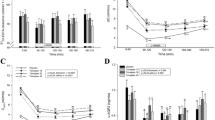Abstract
Background: Previous studies suggest that the acute haemodynamic effects of loop diuretics are due to a direct dilation of blood vessels and are not related to diuretic properties, but possibly to prostaglandin secretion.
Objectives: We investigated whether in vitro human endothelial and renal epithelial cells responded to torasemide or furosemide with enhanced secretion of the vasodilator prostaglandin prostacyclin (PGI2). We also investigated the effects of loop diuretics on plasma concentrations of PGI2 and its physiological antagonist thromboxane after 25 min of administration of drugs in 44 patients with congestive heart failure (CHF) and 44 healthy volunteers.
Methods: The PGI2 levels were measured after extraction in ethyl acetate by RIA as levels of 6-KetoPGF1α, a stable metabolite from a non-enzymatic degradation. TxB2 concentration, the stable hydrolysis product of TxA2, was also measured by RIA.
Results: In human endothelial and renal epithelial cells, both loop diuretics induced an increase of 6-KetoPGF1α secretion that reached a peak after about 5 min and remained stable for 30 min of exposure to the drugs. The magnitude of the phenomenon was lesser in epithelial than in endothelial cells. Moreover, in both cell lines, there was a significantly higher secretion of 6-KetoPGF1α to torasemide than furosemide (P < 0.05). Concentrations of 6-KetoPGF1α at baseline were similar between the groups of CHF patients receiving the two different drugs. After 25 min of both drugs, 6-Keto-PGF1α significantly increased (P < 0.01), and this was significantly higher in patients treated with 10 mg of torasemide (P < 0.05 vs furosemide). Levels of PGI2 at baseline were lower in healthy controls than those reached by CHF patients and similar between groups. After 25 min of both drugs, PGI2 plasma levels were significantly increased (P < 0.01). Baseline values of TxB2 were significantly higher in CHF patients compared with controls (P < 0.01 vs respective groups), and, more importantly, furosemide but not torasemide increased TxB2 levels in patients and controls (P < 0.05 vs baseline).
Conclusions: Our study is the first demonstration in human tissue of increased secretion of PGI2 both in vitro and in vivo, after torasemide or furosemide administration. This phenomenon, which may explain in part the vasodilatory effects of these drugs, was more evident with torasemide and was reached at lower concentrations of the drug. Accordingly, we also found that furosemide but not torasemide stimulated the release of the PGI2 physiological antagonist thromboxane in CHF patients and healthy controls.
Similar content being viewed by others
Author information
Authors and Affiliations
Additional information
Received: 8 May 1998 / Accepted in revised form: 14 August 1998
Rights and permissions
About this article
Cite this article
Liguori, A., Casini, A., Di Loreto, M. et al. Loop diuretics enhance the secretion of prostacyclin in vitro, in healthy persons, and in patients with chronic heart failure. E J Clin Pharmacol 55, 117–124 (1999). https://doi.org/10.1007/s002280050605
Issue Date:
DOI: https://doi.org/10.1007/s002280050605




